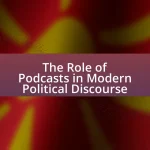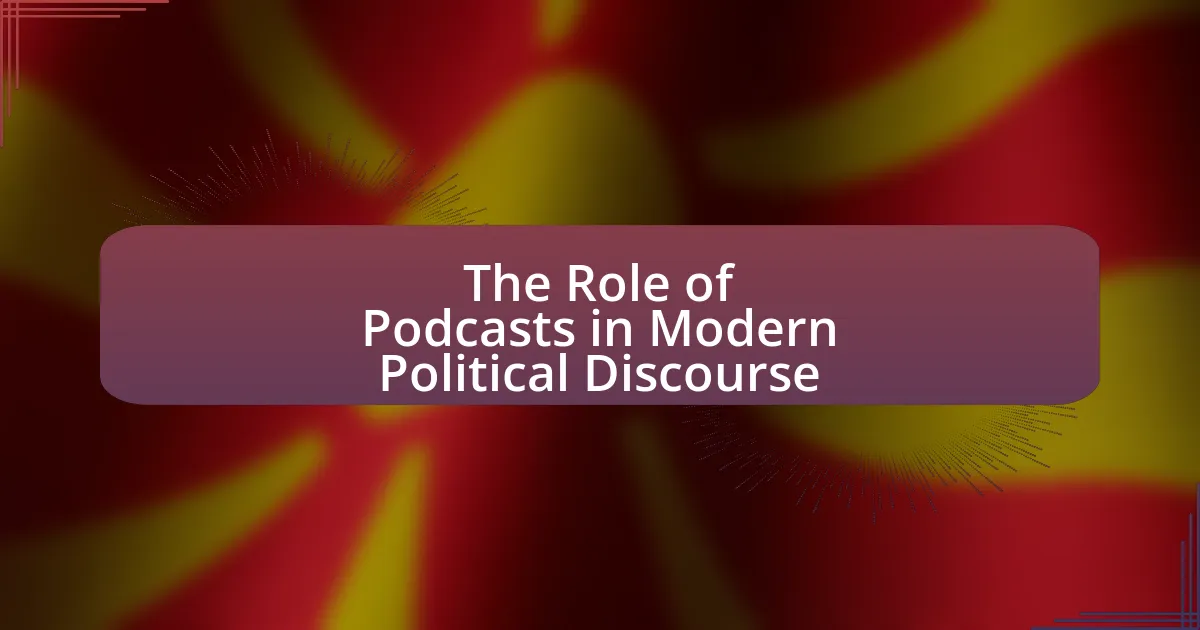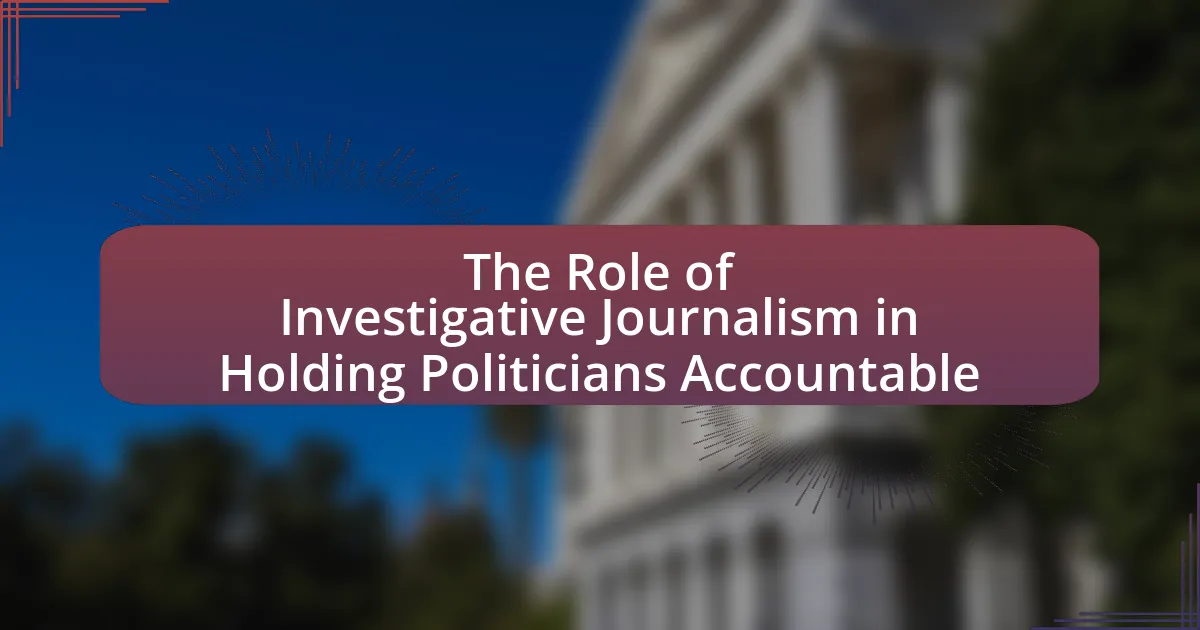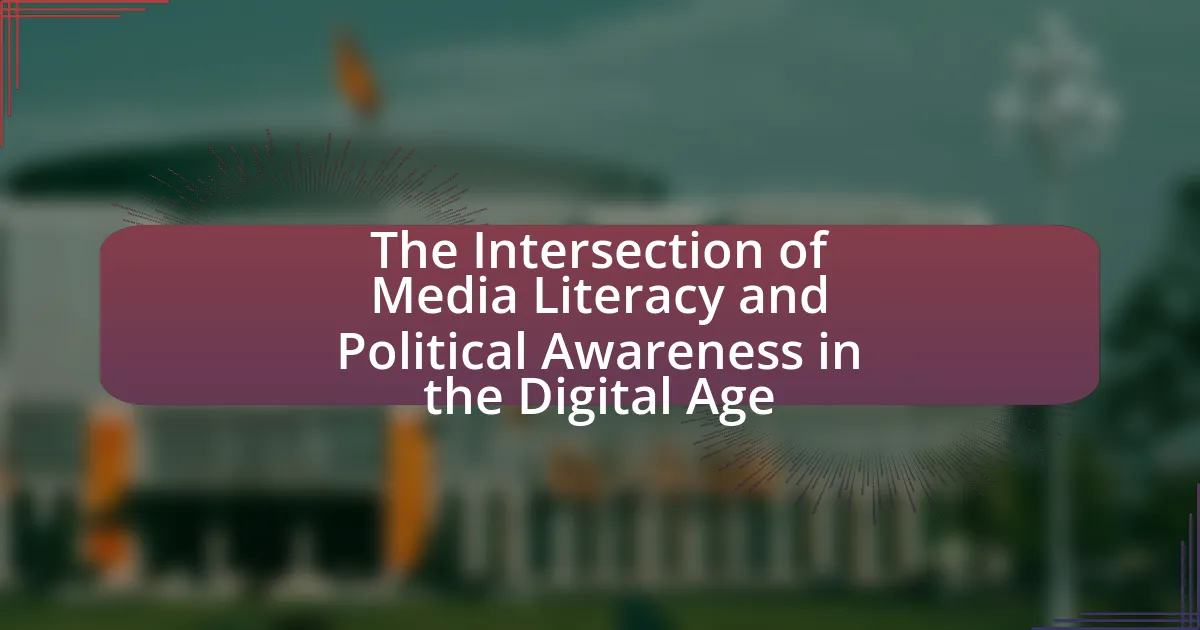The article examines the significant role of social media in shaping political opinions among young voters, highlighting how platforms like Instagram, TikTok, and Twitter facilitate information dissemination, engagement, and community building. It discusses the influence of algorithms on the political content young voters encounter, the effectiveness of social media campaigns in mobilizing this demographic, and the challenges they face, such as misinformation and echo chambers. Additionally, the article outlines strategies used by political campaigns to engage young voters and emphasizes the importance of critical media literacy for informed decision-making in the digital age.
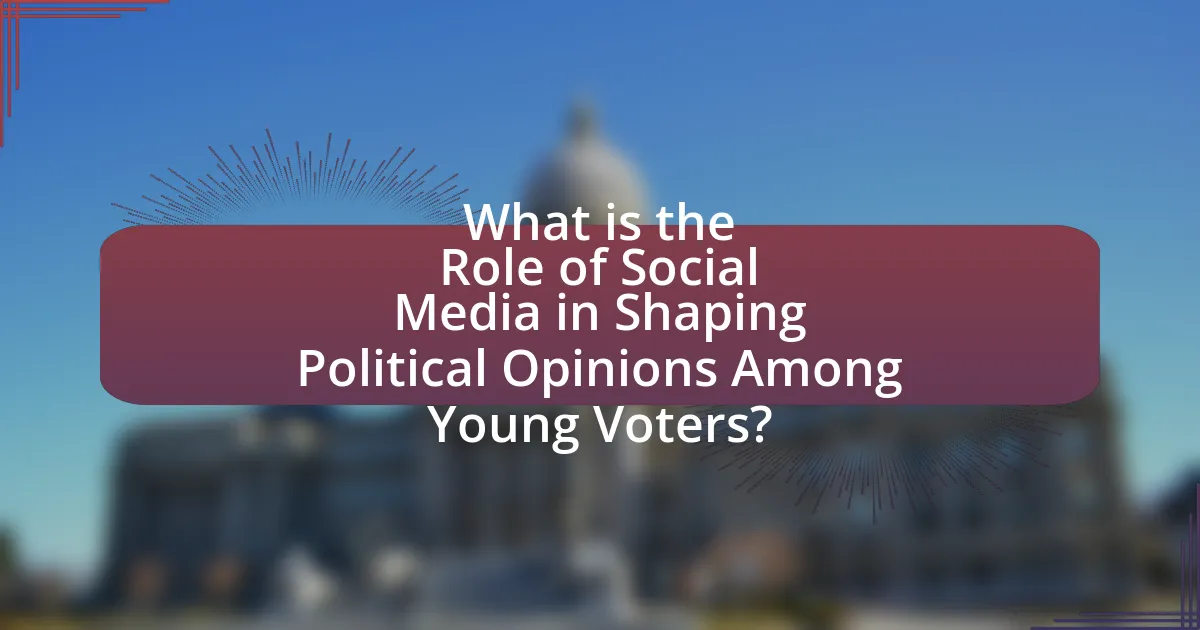
What is the Role of Social Media in Shaping Political Opinions Among Young Voters?
Social media plays a crucial role in shaping political opinions among young voters by providing a platform for information dissemination, engagement, and community building. Young voters increasingly rely on social media for news and political discourse, with studies indicating that 70% of this demographic uses platforms like Facebook, Twitter, and Instagram to follow political events and candidates. This engagement influences their perceptions and attitudes towards political issues, as social media allows for the rapid spread of information, including campaign messages and peer opinions, which can significantly impact voting behavior. Furthermore, algorithms on these platforms often curate content that aligns with users’ interests, reinforcing existing beliefs and shaping political identities.
How does social media influence political engagement among young voters?
Social media significantly enhances political engagement among young voters by providing platforms for information dissemination, discussion, and mobilization. Research indicates that 70% of young people use social media to follow political news, which increases their awareness of political issues and candidates. Additionally, social media facilitates grassroots organizing, allowing young voters to participate in campaigns and movements, as evidenced by the success of initiatives like the March for Our Lives, which gained traction through platforms like Twitter and Instagram. This interconnectedness fosters a sense of community and urgency, motivating young voters to engage in political processes, such as voting and activism.
What platforms are most popular among young voters for political discussions?
Young voters primarily engage in political discussions on platforms such as Instagram, TikTok, and Twitter. Research indicates that 71% of young voters use Instagram for political content, while TikTok has rapidly gained traction, with 63% of users aged 18-29 reporting engagement with political discussions. Twitter remains significant, especially for real-time news and updates, with 36% of young voters utilizing it for political discourse. These platforms facilitate dynamic interactions and allow for the sharing of diverse viewpoints, making them central to the political engagement of younger demographics.
How do algorithms affect the political content young voters see?
Algorithms significantly influence the political content that young voters encounter by personalizing their social media feeds based on user behavior and preferences. These algorithms analyze data such as likes, shares, and comments to curate content that aligns with individual interests, often leading to echo chambers where users are primarily exposed to viewpoints that reinforce their existing beliefs. Research from the Pew Research Center indicates that 64% of Americans believe social media has a mostly negative effect on the way things are going in the country today, highlighting concerns about the polarization of political discourse driven by algorithmic filtering. Consequently, young voters may receive a skewed representation of political issues, which can shape their opinions and voting behavior in significant ways.
Why is social media a significant tool for political campaigns targeting young voters?
Social media is a significant tool for political campaigns targeting young voters because it allows for direct engagement and tailored messaging that resonates with this demographic. Young voters, who are predominantly active on platforms like Instagram, TikTok, and Twitter, consume information differently than older generations, often favoring visual content and interactive formats. According to a Pew Research Center study, 84% of adults aged 18-29 use social media, making it an essential channel for reaching and influencing their political opinions. Additionally, social media enables campaigns to leverage user-generated content and peer influence, which are crucial in shaping the political views of young voters.
What strategies do political campaigns use on social media to reach young voters?
Political campaigns use targeted advertising, engaging content, and influencer partnerships on social media to reach young voters. Targeted advertising allows campaigns to focus on specific demographics, utilizing data analytics to identify and engage young voters effectively. Engaging content, such as memes, videos, and interactive posts, resonates with younger audiences, making political messages more relatable and shareable. Additionally, partnerships with social media influencers leverage their established trust and reach among young voters, amplifying campaign messages. According to a 2020 Pew Research study, 71% of young adults aged 18-29 reported using social media as a primary source for political news, highlighting the effectiveness of these strategies in engaging this demographic.
How do social media influencers impact political opinions among youth?
Social media influencers significantly shape political opinions among youth by leveraging their platforms to disseminate information and engage followers. Research indicates that 70% of young people trust influencers more than traditional media sources, leading to a greater likelihood of adopting the political views presented by these influencers. For instance, a study by the Pew Research Center found that 45% of social media users aged 18-29 reported that they had changed their political views based on content shared by influencers. This demonstrates the powerful role influencers play in shaping political discourse and mobilizing youth engagement in political issues.
What challenges do young voters face when using social media for political information?
Young voters face several challenges when using social media for political information, including misinformation, echo chambers, and a lack of critical media literacy. Misinformation spreads rapidly on social media platforms, leading to confusion and misinformed opinions; for instance, a study by the Pew Research Center found that 64% of Americans believe that fabricated news stories cause confusion about the basic facts of current events. Additionally, echo chambers reinforce existing beliefs, limiting exposure to diverse viewpoints, which can hinder informed decision-making. Furthermore, many young voters lack the critical media literacy skills necessary to discern credible sources from unreliable ones, as highlighted by research from the Stanford History Education Group, which found that only 20% of students could accurately evaluate the credibility of online information.
How does misinformation spread on social media platforms?
Misinformation spreads on social media platforms primarily through user engagement and algorithmic amplification. When users share, like, or comment on misleading content, these interactions signal to algorithms that the content is popular, leading to wider distribution. A study by the Massachusetts Institute of Technology found that false news stories are 70% more likely to be retweeted than true stories, highlighting the rapid spread of misinformation. Additionally, the lack of fact-checking mechanisms and the tendency for sensational content to attract attention further exacerbate the issue, allowing misinformation to proliferate quickly among users, particularly young voters who are more active on these platforms.
What are the effects of echo chambers on young voters’ political views?
Echo chambers significantly polarize young voters’ political views by reinforcing existing beliefs and limiting exposure to diverse perspectives. Research indicates that young individuals who engage primarily with like-minded peers on social media are more likely to develop extreme political opinions, as they receive validation for their views without encountering opposing arguments. A study by the Pew Research Center found that 64% of social media users reported that their online interactions often reflect their own beliefs, which can lead to a distorted understanding of political issues and increased partisanship among young voters.
How can young voters critically evaluate political content on social media?
Young voters can critically evaluate political content on social media by verifying the credibility of sources, analyzing the intent behind the content, and cross-referencing information with reputable news outlets. Research indicates that misinformation spreads rapidly on social media, with a study from MIT showing that false news stories are 70% more likely to be retweeted than true stories. By checking the original source of the information, young voters can discern whether it comes from a reliable organization or an unverified account. Additionally, understanding the motivations behind the content—whether it aims to inform, persuade, or manipulate—can help young voters assess its validity. Engaging with diverse viewpoints and fact-checking claims through established platforms like Snopes or FactCheck.org further enhances their ability to critically evaluate political content.
What role does social media play in mobilizing young voters during elections?
Social media plays a crucial role in mobilizing young voters during elections by facilitating communication, information dissemination, and community engagement. Platforms like Instagram, Twitter, and TikTok enable political campaigns to reach younger demographics effectively, often using targeted advertisements and influencer partnerships to resonate with their interests. According to a study by the Pew Research Center, 50% of young adults aged 18-29 reported that social media influenced their voting decisions in the 2020 U.S. elections. This demonstrates that social media not only informs but also motivates young voters to participate in the electoral process, highlighting its significance in contemporary political mobilization.
How effective are social media campaigns in increasing voter turnout among youth?
Social media campaigns are highly effective in increasing voter turnout among youth. Research indicates that targeted social media efforts can significantly enhance political engagement, with studies showing that young voters who are exposed to campaign messages on platforms like Instagram and Facebook are more likely to participate in elections. For instance, a study by the Pew Research Center found that 50% of young voters reported being influenced by social media in their decision to vote, highlighting the medium’s role in mobilizing this demographic. Additionally, campaigns that utilize interactive content and peer influence strategies have been shown to further amplify voter turnout, demonstrating the tangible impact of social media on youth electoral participation.
What examples exist of successful social media initiatives that engaged young voters?
Successful social media initiatives that engaged young voters include the “Rock the Vote” campaign and the “Vote.org” initiative. Rock the Vote utilized platforms like Instagram and TikTok to create engaging content that resonated with younger audiences, resulting in a significant increase in voter registration among individuals aged 18-29, with a reported 50% increase in registrations during the 2020 election cycle. Vote.org leveraged social media advertising to provide information on how to register and vote, leading to over 4 million users visiting their site in 2020, with a notable uptick in registrations among young voters. These initiatives demonstrate the effectiveness of targeted social media strategies in mobilizing young voters.
What are the implications of social media’s influence on the future of political opinions among young voters?
Social media significantly shapes the future political opinions of young voters by facilitating rapid information dissemination and fostering engagement with diverse viewpoints. This influence is evident as platforms like Twitter and Instagram allow for real-time discussions and mobilization around political issues, leading to increased political awareness and activism among youth. Research indicates that 70% of young voters use social media as their primary source of news, which underscores its role in shaping their political perspectives. Furthermore, algorithms that prioritize sensational content can skew perceptions, potentially leading to polarization. Thus, social media’s impact on young voters is profound, as it not only informs but also influences their political identities and behaviors.
How might social media evolve in its role in political discourse?
Social media is likely to evolve into a more influential platform for political discourse by enhancing user engagement through advanced algorithms and interactive features. As platforms like Twitter and Facebook continue to refine their algorithms, they will increasingly prioritize content that fosters engagement, leading to more dynamic discussions around political issues. For instance, the rise of TikTok has shown how short-form video content can engage younger audiences, making political discourse more accessible and appealing. Additionally, the integration of live streaming and real-time polling features can facilitate immediate feedback and interaction between politicians and constituents, further shaping political opinions. This evolution is supported by data indicating that 72% of young voters use social media to engage with political content, highlighting its growing importance in shaping political opinions among this demographic.
What trends are emerging in young voters’ use of social media for political purposes?
Young voters are increasingly using social media platforms to engage in political discourse, mobilize for causes, and influence their peers. This trend is characterized by a rise in the use of platforms like TikTok and Instagram, where short, impactful content can quickly spread awareness about political issues. According to a 2022 Pew Research Center study, 71% of young adults aged 18-29 reported using social media to follow political news, highlighting a significant shift from traditional news sources to digital platforms. Additionally, young voters are leveraging social media for grassroots organizing, as seen in movements like Black Lives Matter and climate activism, which have gained momentum through viral campaigns. This shift reflects a broader trend of digital activism, where young voters prioritize authenticity and relatability in political messaging, often favoring content that resonates with their values and experiences.
What best practices can young voters adopt for responsible social media use in politics?
Young voters can adopt several best practices for responsible social media use in politics, including verifying information before sharing, engaging in respectful discourse, and diversifying their news sources. Verifying information helps prevent the spread of misinformation, which is crucial given that 64% of Americans believe fake news causes confusion about basic facts. Engaging in respectful discourse fosters constructive conversations, as studies show that civil discussions can lead to better understanding and reduced polarization. Diversifying news sources ensures exposure to a range of perspectives, which is essential for informed decision-making, as relying on a single source can create echo chambers that distort reality.

